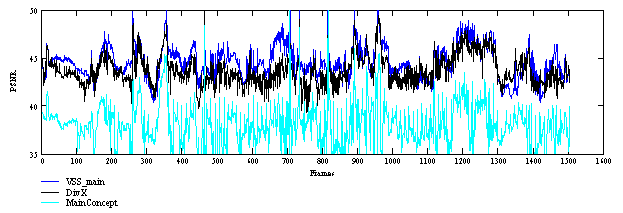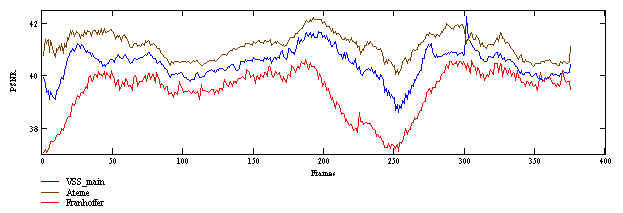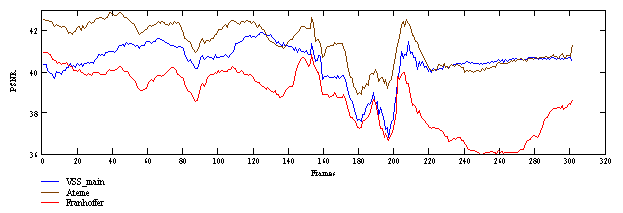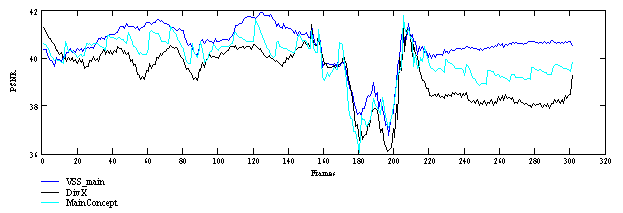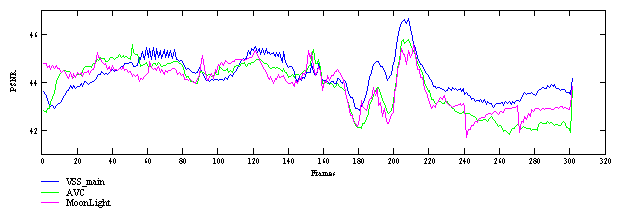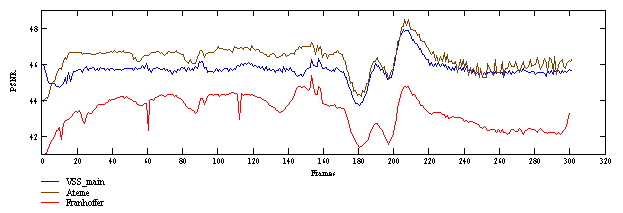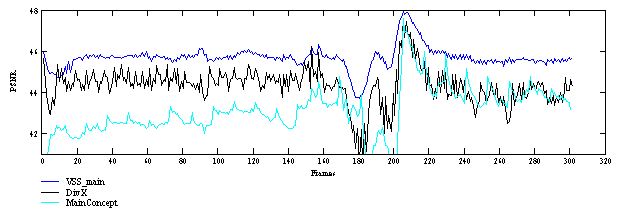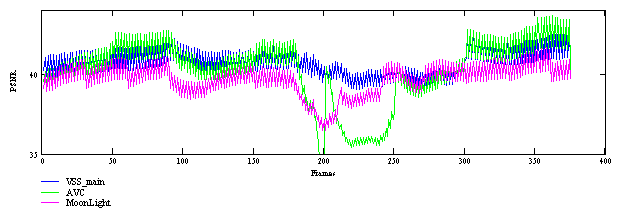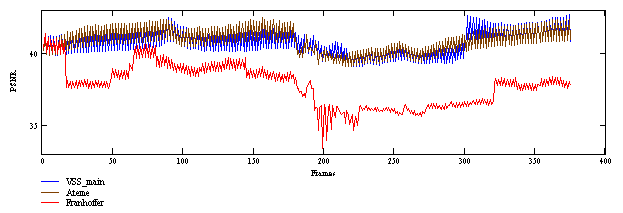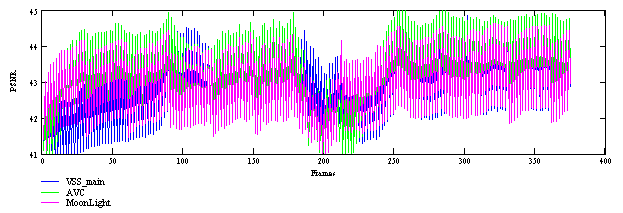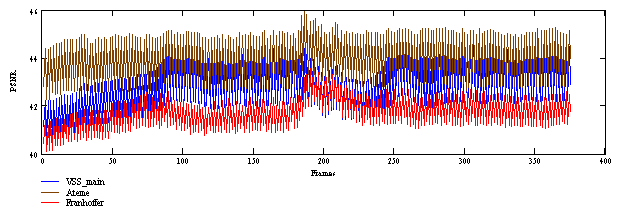First Annual MSU MPEG-4 AVC/H.264 Video Codec ComparisonFor professional users and codec authorsMSU Graphics & Media Lab (Video Group)Return to first H.264/AVC comparison home page! Part3. Additional testingContentsAverage brightness shift diagramsThese diagrams show average shift of brightness produced by the codecs. Coordinates of the basic points represent average brightness values for the whole sequence and the number of measurement (bit rate). So each branch contains ten points that correspond to different bit rates. Bankomatdi sequence
Picture 36. Y-difference. Sequence bankomatdi Conclusions:
Battle sequence
Picture 37. Y-difference. Sequence battle Conclusions:
Bbc3di sequence
Picture 38. Y-difference. Sequence bbc3di Conclusions:
Foreman sequence
Picture 39. Y-difference. Sequence foreman Conclusions:
Susidi sequence
Picture 40. Y-difference. Sequence susidi Conclusions:
Bit rate handling diagramsThese diagrams show how codecs handle different bit rates. Every branch consists of ten points that correspond to different bit rates. Value "1" means that the codec keeps the specified bit rate; value more than "1" means that the codec actually compresses with the higher bit rate than was specified. Bankomatdi sequence
Picture 41. Bit rate handling. Sequence bankomatdi Conclusions:
Battle sequence
Picture 42. Bit rate handling. Sequence battle Conclusions:
Bbc3di sequence
Picture 43. Bit rate handling. Sequence bbc3di Conclusions:
Foreman sequence
Picture 44. Bit rate handling. Sequence foreman Conclusions:
Susidi sequence
Picture 45. Bit rate handling. Sequence susidi Conclusions:
Per frame sequences comparisonThese diagrams show how compression quality changes from frame to frame. X-axis coordinate represents the number of the frame and Y-axis coordinate represents PSNR-value for this frame. Significant constant difference on the susidi diagram is caused by the noise suppression in every second frame (B-frames options in MPEG-2 coder). Bankomatdi sequenceBit rate = 100 Kb/sec
Bit rate = 700 Kb/sec
Bit rate = 2340 Kb/sec
Battle sequenceBit rate = 100 Kb/sec
Bit rate = 700 Kb/sec
Bit rate = 2340 Kb/sec
Bbc3di sequenceBit rate = 100 Kb/sec
Bit rate = 700 Kb/sec
Bit rate = 2340 Kb/sec
Foreman sequenceBit rate = 100 Kb/sec
Bit rate = 700 Kb/sec
Bit rate = 2340 Kb/sec
Susidi sequenceBit rate = 100 Kb/sec
Bit rate = 700 Kb/sec
Bit rate = 2340 Kb/sec
Visual comparison of H.264 and DivX codecs
Bbc3di sequence, frame 280The following examples demonstrate better image quality after compression with the H.264 codec in comparison with DivX.
Foreman sequence, frames 282 and 9The following examples demonstrate better image quality after compression with the H.264 codec in comparison with DivX.
Conclusion:
The following examples demonstrate close results from the image quality point of view for DivX and H.264.
|
Contents
Download
- MSU H.264/MPEG-4 AVC Codecs Comparison - PDF (3248 Kb)
- MSU H.264/MPEG-4 AVC Codecs Comparison - ZIP (2709 Kb)
Contact Information
 |
Additional information
See all MSU Video Codecs Comparisons
MSU video codecs comparisons resources:
- Introduction to Video Codecs Comparison
- Lossless Video Codecs Comparison 2004 (October 2004)
- MPEG-4 SP/ASP Video Codecs Comparison (March 2005)
- JPEG 2000 Image Codecs Comparison (September 2005)
- First Annual MPEG-4 AVC/ H.264 Video Codecs Comparison (January 2005)
- Second Annual MPEG-4 AVC/H.264 Video Codec Comparison (December 2005)
- Subjective Comparison of Modern Video Codecs (February 2006)
- MPEG-2 Video Decoders Comparison (May 2006)
- WMP and JPEG2000 Comparison (October 2006)
- Third Annual MPEG-4 AVC/H.264 Comparison (December 2006) (All versions for free!)
- Lossless Video Codecs Comparison 2007 (March 2007)
- Fourth Annual MPEG-4 AVC/H.264 Comparison (December 2007) (All versions for free!)
- Options Analysis of MPEG-4 AVC/H.264 Codec x264 (December 2008)
- Fifth MPEG-4 AVC/H.264 Comparison (May 2009) (All versions for free!)
- Sixth MPEG-4 AVC/H.264 Comparison (May 2010)
- Seventh MPEG-4 AVC/H.264 Comparison (May 2011)
- Eighth MPEG-4 AVC/H.264 Comparison (May 2012)
- Ninth MPEG-4 AVC/H.264 Comparison (Dec 2013)
- Tenth Video Codec Comparison (HEVC) (Oct 2015)
- Eleventh Video Codec Comparison (HEVC) (Aug 2016)
- Twelfth Video Codec Comparison (HEVC) (Aug 2017)
- Thirteen Video Codec Comparison (HEVC) (Aug 2018)
- Fourteen Video Codec Comparison (HEVC) (Sept 2019)
- Cloud Encoding Servoces Comparison 2019 (Dec 2019)
- Fifteen Video Codec Comparison (HEVC) (Dec 2020)
- Sixteen Video Codec Comparison (Dec 2021)
- Seventeen Video Codecs Comparisons (Nov 2022)
- Eighteenth Video Codecs Comparisons (Apr 2025)
- Nineteenth Video Codecs Comparisons (2025)
- Codec Analysis for Companies:
Other materials
Video resources:
Server size: 8069 files, 1215Mb (Server statistics)
Project updated by
Server Team and
MSU Video Group
Project sponsored by YUVsoft Corp.
Project supported by MSU Graphics & Media Lab



























